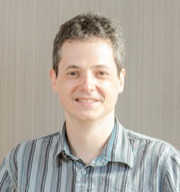Keynotes
Jernej Barbic
Model reduction for elasticity problems in computer graphics and animation
In nature, there are many dynamical systems that are reasonably well-understood from the viewpoint of physics, but are computationally slow to simulate with detailed models. The observed transients in many simulations are, however, often not very rich, but exhibit primarily simple, low-dimensional dynamics. Such observations form the cornerstone of model reduction, an interdisciplinary technique used in electrical and aerospace engineering, as well as solid and fluid mechanics, and computer graphics. In my career, I have studied how model reduction can be applied to elasticity problems in computer graphics and animation. I will present my work on model reduction applied to fast simulation, optimal control, optimization, collision detection, sound simulation and interactive design of geometrically and materially complex models undergoing large deformations.

Prof. Dr. Andreas Weber
Exponential integrators - a silver bullet for physics-based simulation?
Particle systems have been very popular for physics-based modeling in computer animation. However, for many problems those lead to very stiff initial value problems that traditionally have been solved by implicit methods. Nevertheless, implicit methods have several drawbacks ranging from the addition of artificial damping to relatively high computational costs. In contrast, exponential integrators that solve the linear part of a problem by computing matrix exponentials combining those with the non-linear part using appropriate filter functions can use efficient methods to compute matrix exponentials and are very efficient in general, as very often the stiff parts of the problems are linear. We will exemplify our methods and results - which are part of the PhD thesis of Dominik Michels that was supervised by the author - on a wide variety of examples including challenging dynamics simulations of interacting (hair-)fibers.

His research interests include physics-based modeling and data driven methods for motion synthesis, analysis, and reconstruction. He has supervised 4 PhD thesis in the context of human hair modeling covering aspects from physics-based rendering and inverse rendering over hair-style reconstruction from (thermal) images to the dynamics simulation of interacting hair fibers.









